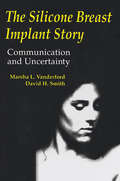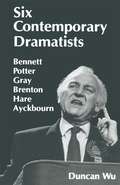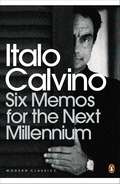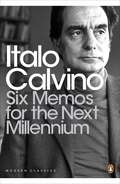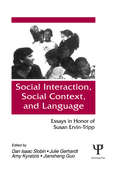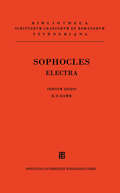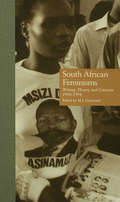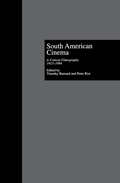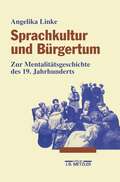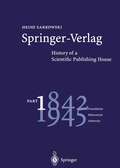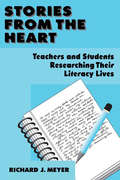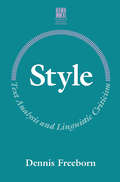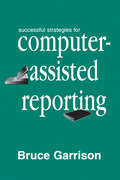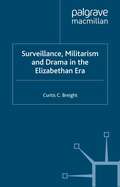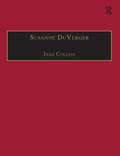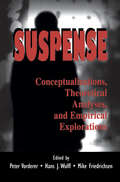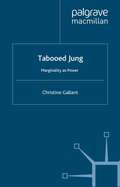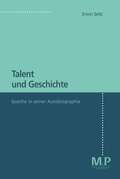- Table View
- List View
The Silicone Breast Implant Story: Communication and Uncertainty (Routledge Communication Series)
by Marsha L. Vanderford David H. SmithThis volume examines one health issue -- breast implants -- across a series of contexts often thought to be separate -- media coverage, doctor-patient interaction, doctor-doctor professional communication, support group dialogues, public relations campaigns, and more. In so doing, it provides a narrative of how communication shapes the individual perceptions of health, government, and social policy concerning health care. At the core of the silicone breast implant controversy is the need for people to act amid uncertainty about the health risks involved. This need to weigh action in the midst of uncertain risk characterizes a large number of health issues. The attempts of patients, physicians, drug manufacturers, and others to seek and provide both information and influence makes communication central to these issues. Consequently, the questions explored in this volume will interest a diverse group of readers. This audience includes plastic surgeons in particular, physicians in general, and anyone involved with women's health issues. As the medical profession struggles with its identity amid changes in public attitudes, government regulations, and medical practices, this volume's findings concerning media portrayals of doctors and medical devices become even more important. Finally, this study reveals how interrelated public information and private decisions are, and how closely media and interpersonal relationships fit. Tracing one medical issue across interpersonal, organizational, public relations, and mediated forums has clearly demonstrated the multiple ways those communication channels overlap and inform one another.
Six Contemporary Dramatists: Bennett, Potter, Gray, Brenton, Hare, Ayckbourn
by Duncan Wu`A most illuminating study.' - John Bayley Six Contemporary Dramatists explores, in a straightforward manner, the central concerns of six of the most important contemporary dramatists. It demonstrates how the work of Alan Bennett, Dennis Potter, Simon Gray, Howard Brenton, David Hare and Alan Ayckbourn is essentially moral, and relates their aspirations to the British romantic tradition of the last century. At the same time, Duncan Wu explores how each writer has responded to the changes that took place in personal and public ethics during the 1980s as a result of Thatcherism. He also includes an interview with Alan Ayckbourn, published here for the first time, in which the volume's themes are focused and summarised. For the paperback edition, a substantial preface discussing Tom Stoppard's Arcadia, David Hare's Skylight and David Edgar's Pentecost has been added. This is an essential and readable guide to televised and theatrical drama for students and theatregoers alike.
Six Memos for the Next Millennium (Virago Modern Classics #391)
by Italo Calvino Martin McLaughlin Patrick CreaghItalo Calvino was due to deliver the Charles Eliot Norton lectures at Harvard in 1985-86, but they were left unfinished at his death. The surviving drafts explore of the concepts of Lightness, Quickness, Multiplicity, Exactitude and Visibility (Constancy was to be the sixth) in serious yet playful essays that reveal Calvino's debt to the comic strip and the folktale. With his customary imagination and grace, he sought to define the virtues of the great literature of the past in order to shape the values of the future. This collection is a brilliant précis of the work of a great writer whose legacy will endure through the millennium he addressed.Italo Calvino, one of Italy's finest postwar writers, has delighted readers around the world with his deceptively simple, fable-like stories. Calvino was born in Cuba in 1923 and raised in San Remo, Italy; he fought for the Italian Resistance from 1943-45. His major works include Cosmicomics (1968), Invisible Cities (1972), and If on a winter's night a traveler (1979). He died in Siena in1985, of a brain hemorrhage.
Six Memos for the Next Millennium (Penguin Modern Classics #391)
by Italo Calvino Geoffrey Brock'Words connect the visible track to the invisible thing ... like a fragile makeshift bridge cast across the void'With imagination and wit, Italo Calvino sought to define the virtues of the great literature of the past in order to shape the values of the future. His effervescent last works, left unfinished at his death, were the Charles Eliot Norton lectures, which he was due to deliver at Harvard in 1985-86. These surviving drafts explore the literary concepts closest to his heart: Lightness, Quickness, Multiplicity, Exactitude and Visibility (Constancy was to be the sixth), in serious yet playful essays that reveal his debt to the comic strip and the folktale. This collection, now in a fluent and supple new translation, is a brilliant précis of a great writer whose legacy will endure through the millennium he addressed.Translated by Geoffrey Brock 'The book I give most to people is Six Memos for the Next Millennium' Ali Smith'Wonderful . . . full of wit and erudition' Daily Telegraph
Social interaction, Social Context, and Language: Essays in Honor of Susan Ervin-tripp
by Dan Isaac Slobin Julie Gerhardt Amy Kyratzis Jiansheng GuoThis collection of essays is a representative sample of the current research and researchers in the fields of language and social interactions and social context. The opening chapter, entitled "Context in Language," is written by Susan Ervin-Tripp, whose diverse and innovative research inspired the editors to dedicate this book to her honor. Ervin-Tripp is known for her work in the fields of linguistics, psychology, child development, sociology, anthropology, rhetoric, and women's studies. She has played a central role in the definition and establishment of psycholinguistics, child language development, and sociolinguistics, and has been an innovator in terms of approaches and methods of study. This book covers a wide range of research interests in the field, from linguistically oriented approaches to social and ethnography oriented approaches. The issue of the relationships between forms and structures of language and social interactions is examined in studies of both adult and child speech. It is a useful anthology for graduate students studying language and social interaction, as well as for researchers in this field.
Social interaction, Social Context, and Language: Essays in Honor of Susan Ervin-tripp
by Dan Isaac Slobin Julie Gerhardt Amy Kyratzis Jiansheng GuoThis collection of essays is a representative sample of the current research and researchers in the fields of language and social interactions and social context. The opening chapter, entitled "Context in Language," is written by Susan Ervin-Tripp, whose diverse and innovative research inspired the editors to dedicate this book to her honor. Ervin-Tripp is known for her work in the fields of linguistics, psychology, child development, sociology, anthropology, rhetoric, and women's studies. She has played a central role in the definition and establishment of psycholinguistics, child language development, and sociolinguistics, and has been an innovator in terms of approaches and methods of study. This book covers a wide range of research interests in the field, from linguistically oriented approaches to social and ethnography oriented approaches. The issue of the relationships between forms and structures of language and social interactions is examined in studies of both adult and child speech. It is a useful anthology for graduate students studying language and social interaction, as well as for researchers in this field.
South African Feminisms: Writing, Theory, and Criticism,l990-l994 (Gender and Genre in Literature)
by M. J. DaymondThis is the first collection of feminist critical essays by and about women in South Africa to appear outside of that country. Many of the pieces were written after February 1990, when President de Klerk lifted the ban on black political organizations. The recognition that a just society cannot be achieved without freedom from gender oppression as well as racial oppression informs these essays and has a direct bearing on the creation of a new society in South Africa.
South African Feminisms: Writing, Theory, and Criticism,l990-l994 (Gender and Genre in Literature #Vol. 5)
by M. J. DaymondThis is the first collection of feminist critical essays by and about women in South Africa to appear outside of that country. Many of the pieces were written after February 1990, when President de Klerk lifted the ban on black political organizations. The recognition that a just society cannot be achieved without freedom from gender oppression as well as racial oppression informs these essays and has a direct bearing on the creation of a new society in South Africa.
South American Cinema: A Critical Filmography, l915-l994
by Timothy Barnard Peter RistFirst Published in 1996. Routledge is an imprint of Taylor & Francis, an informa company.
South American Cinema: A Critical Filmography, l915-l994 (Historical Dictionaries Of Literature And The Arts Ser.)
by Timothy Barnard Peter RistFirst Published in 1996. Routledge is an imprint of Taylor & Francis, an informa company.
Springer-Verlag: Part 1: 1842–1945 Foundation Maturation Adversity
by Heinz SarkowskiThis book describes the fortunes and activities of one of the few specialist publishing houses still in the hands of the same family that established it over years ago, and with it gives a p- trayal of those members who directed it. In doing so it covers a period of momentous historical events that directly and in- rectly shaped the firm's actions and achievements. But this volume tells not only, in word and picture, the story of Springer- Verlag but also, interwoven with it, the story of scientific p- lishing in Germany over the span of a hundred years. The text, densely packed with carefully researched facts and figures, is illuminated and supplemented by many illustrations whose captions, together with the author's notes, contain a wealth of important and interesting information. The reader is urged to read these captions as well as the notes so as to - preciate in full the events and people described. I have added a few footnotes to clarify or expand on some matters that may be unfamiliar to non-German readers. Because of the long period of time covered in these pages many of the documents and letters shown and commented upon are different in diction and style from those of today. An - tempt was made in the translation to keep the flavour of the original language and not contemporise it.
Stories From the Heart: Teachers and Students Researching their Literacy Lives
by Richard J. MeyerStories from the Heart is for, by, and about prospective and practicing teachers understanding themselves as curious and literate beings, making connections with colleagues, and researching their own literacy and the literacy lives of their students. It demonstrates the power and importance of story in our own lives as literate individuals. Readers are encouraged to: tell, write, or re-create the stories of their literacy lives in order to understand how they learn and teach; begin the journey into writing the stories of others' literacy lives; find support in their researching endeavors; and examine the idea of framing stories by using the work of other teachers and researchers.
Stories From the Heart: Teachers and Students Researching their Literacy Lives
by Richard J. MeyerStories from the Heart is for, by, and about prospective and practicing teachers understanding themselves as curious and literate beings, making connections with colleagues, and researching their own literacy and the literacy lives of their students. It demonstrates the power and importance of story in our own lives as literate individuals. Readers are encouraged to: tell, write, or re-create the stories of their literacy lives in order to understand how they learn and teach; begin the journey into writing the stories of others' literacy lives; find support in their researching endeavors; and examine the idea of framing stories by using the work of other teachers and researchers.
Style: Text Analysis and Linguistic Criticism (Studies in English Language)
by Dennis FreebornThis new coursebook offers teachers and students a thorough and lively guide to stylistic and critical analysis of a range of texts, both literary and non-literary, classic and contemporary. Full of examples and exercises, this is an invaluable book for all students of English language and its usage.
Successful Strategies for Computer-assisted Reporting (Routledge Communication Series)
by Bruce GarrisonComputers have changed the landscape of both gathering and disseminating information throughout the world. As journalists quickly move toward the 21st century and perhaps, a new era of electronic journalism, resources are needed to understand the newest and most successful computer-based news reporting strategies. Written to serve that purpose, this book is designed to show both professional journalists and students which of the newest personal computing tools are being used by the nation's leading news organizations and top individual journalists. It further describes how these resources are being used on a daily basis and for special projects. In recent years, computers have taken on new and dominating roles in the process of news analysis, newsgathering, and news processing. Today's forward-thinking journalists often seek guidance over what they can do to strengthen their ability to be society's information processors and managers. This volume focuses upon how successful journalists are using computers through a major national computer-assisted reporting (CAR) study of daily newspapers. The study included two national surveys and a series of personal interviews with many of the nation's leading CAR specialists. Several current examples of stories used for successful database- and online-oriented news assignments are provided as part of a series of case studies incorporated throughout the book. The additional depth of description and the presentation of portions of stories themselves should help readers to understand the complete process involving CAR-oriented journalism. Substantial analytical detail is used to discuss the extent of computer use in newsrooms, computer training, CAR projects, CAR in daily reporting, hardware and software most commonly used, levels and types of online services used in news research, and portable hardware and software. The book concludes with the author's assessment of the effects and impact of personal computing in the newsroom and the future of personal computer applications in newsgathering. Explaining and defining advanced applications or terminology for readers, the approach to the book assumes a minimal familiarity with computers, but no advanced knowledge of computer operation.
Successful Strategies for Computer-assisted Reporting (Routledge Communication Series)
by Bruce GarrisonComputers have changed the landscape of both gathering and disseminating information throughout the world. As journalists quickly move toward the 21st century and perhaps, a new era of electronic journalism, resources are needed to understand the newest and most successful computer-based news reporting strategies. Written to serve that purpose, this book is designed to show both professional journalists and students which of the newest personal computing tools are being used by the nation's leading news organizations and top individual journalists. It further describes how these resources are being used on a daily basis and for special projects. In recent years, computers have taken on new and dominating roles in the process of news analysis, newsgathering, and news processing. Today's forward-thinking journalists often seek guidance over what they can do to strengthen their ability to be society's information processors and managers. This volume focuses upon how successful journalists are using computers through a major national computer-assisted reporting (CAR) study of daily newspapers. The study included two national surveys and a series of personal interviews with many of the nation's leading CAR specialists. Several current examples of stories used for successful database- and online-oriented news assignments are provided as part of a series of case studies incorporated throughout the book. The additional depth of description and the presentation of portions of stories themselves should help readers to understand the complete process involving CAR-oriented journalism. Substantial analytical detail is used to discuss the extent of computer use in newsrooms, computer training, CAR projects, CAR in daily reporting, hardware and software most commonly used, levels and types of online services used in news research, and portable hardware and software. The book concludes with the author's assessment of the effects and impact of personal computing in the newsroom and the future of personal computer applications in newsgathering. Explaining and defining advanced applications or terminology for readers, the approach to the book assumes a minimal familiarity with computers, but no advanced knowledge of computer operation.
Surveillance, Militarism and Drama in the Elizabethan Era (Language, Discourse, Society)
by C. BreightCurtis Breight challenges the view that Renaissance English rulers could not dominate their domestic population. He argues, alternatively, that the Elizabethan state was controlled by the Cecilian faction, which maintained power by focusing English energies outwardly. Cecilians launched relentless assaults by land and sea against England's neighbours. By the 1590s their policies had enriched a few yet destroyed countless people, and this book reads the drama of Christopher Marlowe and William Shakespeare in relation to ongoing national and international conflict.
Susanne DuVerger: Printed Writings 1500–1640: Series 1, Part One, Volume 5 (The Early Modern Englishwoman: A Facsimile Library of Essential Works & Printed Writings, 1500-1640: Series I, Part One)
by Jane CollinsThe one work traditionally attributed to Susan DuVerger is her Admirable Events (1639) - a translation of a collection of novellas by Jean Pierre Camus, a French Catholic Bishop - which she dedicated to Queen Henrietta Maria. There is some evidence however to suggest that she was the author of several other works. What little is known of her is based on her literary production - various factors suggest that she was an English Catholic who spent time in exile in France during the Civil War.
Susanne DuVerger: Printed Writings 1500–1640: Series 1, Part One, Volume 5 (The Early Modern Englishwoman: A Facsimile Library of Essential Works & Printed Writings, 1500-1640: Series I, Part One)
by Jane CollinsThe one work traditionally attributed to Susan DuVerger is her Admirable Events (1639) - a translation of a collection of novellas by Jean Pierre Camus, a French Catholic Bishop - which she dedicated to Queen Henrietta Maria. There is some evidence however to suggest that she was the author of several other works. What little is known of her is based on her literary production - various factors suggest that she was an English Catholic who spent time in exile in France during the Civil War.
Suspense: Conceptualizations, Theoretical Analyses, and Empirical Explorations (Routledge Communication Series)
by Peter Vorderer Hans Jürgen Wulff Mike FriedrichsenThis volume begins with the general assumption that suspense is a major criterion for both an audience's selection and evaluation of entertaining media offerings. This assumption is supported not only by the popularity of suspenseful narratives, but also by the reasons users give for their actual choice of media contents. Despite this, there is no satisfying theory to describe and explain what suspense actually is, how exactly it is caused by films or books, and what kind of effect it has on audiences. This book's main objective is to provide that theory by bringing together scholars from different disciplines who are working on the issue. The editors' goal is to reflect the "state of the art" as much as it is to highlight and encourage further developments in this area. There are two ways of approaching the problem of describing and explaining suspense: an analysis of suspenseful texts or the reception process. Researchers who follow the more text-oriented approach identify the uncertainty of the narrative outcome, the threat or danger for the protagonist, the play with time delay, or other factors as important and necessary for the production of suspense. The more reception-oriented scholar focuses on the cognitive activities of audiences, readers' expectations, the curiosity of onlookers, their emotions, and their relationships with the protagonists. A correspondence between the two seems to be quite difficult, though necessary to determine. Both perspectives are important in order to describe and explain suspense. Thus, the editors utilize the thesis that suspense is an activity of the audience (reader, onlooker, etc.) that is related to specific features and characteristics of the text (books, films, etc.). Their question is: What kind of relation? The answer comes from finding out how, why, and which elements of the text cause effects that are experienced as suspense. Scholars from semiotics, literary criticism, cultural studies, and film theory assess the problem from a text-oriented point of view, dealing primarily with the how and which. Other scholars present the psychological perspective by focusing on the cognitive and emotional processes that underlie viewers' experience of suspense; that is, the reception theory tries to answer the question of why suspenseful texts may be experienced as they are.
Suspense: Conceptualizations, Theoretical Analyses, and Empirical Explorations (Routledge Communication Series)
by Peter Vorderer Hans J. Wulff Mike FriedrichsenThis volume begins with the general assumption that suspense is a major criterion for both an audience's selection and evaluation of entertaining media offerings. This assumption is supported not only by the popularity of suspenseful narratives, but also by the reasons users give for their actual choice of media contents. Despite this, there is no satisfying theory to describe and explain what suspense actually is, how exactly it is caused by films or books, and what kind of effect it has on audiences. This book's main objective is to provide that theory by bringing together scholars from different disciplines who are working on the issue. The editors' goal is to reflect the "state of the art" as much as it is to highlight and encourage further developments in this area. There are two ways of approaching the problem of describing and explaining suspense: an analysis of suspenseful texts or the reception process. Researchers who follow the more text-oriented approach identify the uncertainty of the narrative outcome, the threat or danger for the protagonist, the play with time delay, or other factors as important and necessary for the production of suspense. The more reception-oriented scholar focuses on the cognitive activities of audiences, readers' expectations, the curiosity of onlookers, their emotions, and their relationships with the protagonists. A correspondence between the two seems to be quite difficult, though necessary to determine. Both perspectives are important in order to describe and explain suspense. Thus, the editors utilize the thesis that suspense is an activity of the audience (reader, onlooker, etc.) that is related to specific features and characteristics of the text (books, films, etc.). Their question is: What kind of relation? The answer comes from finding out how, why, and which elements of the text cause effects that are experienced as suspense. Scholars from semiotics, literary criticism, cultural studies, and film theory assess the problem from a text-oriented point of view, dealing primarily with the how and which. Other scholars present the psychological perspective by focusing on the cognitive and emotional processes that underlie viewers' experience of suspense; that is, the reception theory tries to answer the question of why suspenseful texts may be experienced as they are.
Tabooed Jung: Marginality As Power
by C. GallantEver since Jung's break with Freud, he has been excluded from both the psychoanalytic discourse and those schools of literary criticism influenced by psychoanalysis. But this very exclusion has shaped the discourse. Further, many of the analytic writings of Jung and the post-Jungian school of Developmental Jungians are parallel to work by contemporary ego psychologists and feminists, and could contribute to those fields. Jung's entire case throws much light upon the state of marginalization, its effects and its powers.
